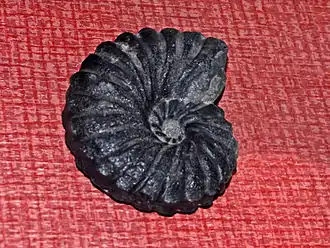Heinzia
Heinzia is an extinct ammonoid cephalopod genus belonging to the family Pulchelliidae.[3] They lived during the Cretaceous, in the Barremian age.[1][2]
| Heinzia | |
|---|---|
 | |
| Fossil shell of Heinzia colleti from Colombia, on display at Galerie de paléontologie et d'anatomie comparée in Paris | |
| Scientific classification | |
| Kingdom: | |
| Phylum: | |
| Class: | |
| Subclass: | |
| Order: | |
| Suborder: | |
| Superfamily: | |
| Family: | |
| Subfamily: | Pulchelliinae |
| Genus: | Heinzia Sayn, 1890 |
Distribution
Fossils of species within this genus have been found in the Cretaceous sediments of Colombia, France, Italy, Morocco and Spain.[1]
References
- The Paleobiology Database
- Sepkoski, Jack Sepkoski's Online Genus Database – Cephalopoda
- "Heinzia caicedi". Ammonites et autres spirales (in French). Retrieved 2016-12-08.
- Crioceratites
- Jean Vermeulen Origine, classification et évolution des Pulchellinae (Douville) 1911 emend. Vermeulen 1995 (Pulchelliidae, Endemoceratoidea)
- C. W. Wright, J. H. Calloman and M. K. Howarth, 1996 Treatise on invertebrate paleontology, volume 4 : cretaceous ammonoidea
- Vermeulen, Jean., 1995: A new division in three parts of the Pulchelliidae family Ammonoidea Riviera Scientifique, 65-80
| Wikispecies has information related to Heinzia. |
This article is issued from Wikipedia. The text is licensed under Creative Commons - Attribution - Sharealike. Additional terms may apply for the media files.
